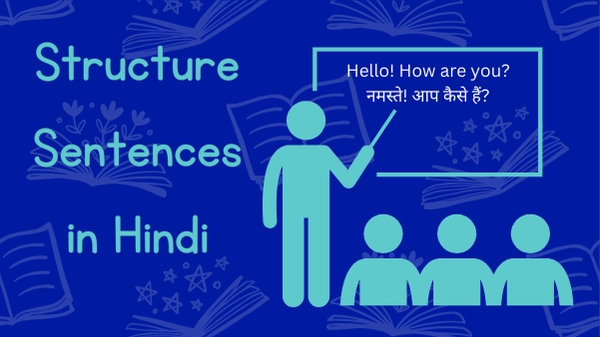When English speakers learn European languages, such as Spanish, hello becomes hola–only two syllables. Easy peasy lemon squeezy, right? But when learning Hindi, the same hello becomes namaskar–a total of three syllables.
Undoubtedly, learning Hindi or any Indian language is harder for English speakers than learning languages like French or German. As a matter of fact, Americans find learning Hindi complex and confusing, especially when it comes to Hindi sentence structure and grammar.
However, before learning Hindi grammar, you must know how to structure sentences in Hindi.

Let’s Declare! How to Say Declarative/Assertive Sentences in Hindi?
First, let me take you through declarative or assertive sentences. What does it mean?
Declarative or assertive sentences are those which you use to say your opinion or a fact.
For instance: I eat apples.
You are saying you eat apples and that’s a fact–an assertive sentence. But if you say I like apples, that’s an opinion–a declarative sentence. Okie dokie. Now, let’s try to say the same sentences in Hindi and also understand the sentence structure.
I+ eat + apples.
Subject + Verb + Object
As you already know, in English, the basic sentence structure is subject+verb+object.
Contrastingly, in Hindi subject object verb is the most common structure.
In English:
I + eat + apples.
Subject + Verb + Object
In Hindi:
Main apple khata hu
Subject + object + verb
Now, let’s try the same with an opinion: “I like apples”
Main apple pasand karta hu
Subject + object + verb
Next, assertive or declarative sentences are either positive or negative, like everything in the world. So, let’s find out how to say such sentences in Hindi.

Learn Hindi from Native Speakers
Take Hindi Classes from our Hindi Speakers. Improve spoken and written Hindi in no time. Start Now!

Let’s Try Some Affirmations and Negations
What are affirmative sentences?
An affirmative sentence is a positive declaration or statement.
For example: Lily lives in Los Angeles .
In the above example, the sentence structure is subject+verb+object.
As you have seen above, in Hindi the sentence structure is subject+object+verb.
In English
Lily + lives + in Los Angeles.
Subject + Verb + Object
In Hindi
Lily Los Angeles mein rehti hai
Subject + object + verb

What are Negative sentences?
Negative sentences are, as the name suggests, stating or declaring something negative. In short, it’s completely opposite to affirmative sentences.
For example: I don’t eat apples .
In English:
I + do not eat + apples.
Subject + Verb + Object
In Hindi:
Main apple nahi khata hu
Subject + object + verb
So, this is how you say negative sentences in Hindi. To make sure it’s clear, let’s try one more.
In English
He doesn't eat + apples.
Subject + Verb + Object
In Hindi
Wo apple nahi khata hai.
Subject + object + verb

How to Write Imperative Sentences In Hindi?
1. What are Imperative Sentences?
Imperative sentences are those which you say to request, command, or instruct someone.
If you’re learning Hindi to visit India, you should definitely learn how to make imperative sentences.
Let’s begin with an easy sentence: You should visit India.
In English:
You + should visit + India.
Subject + Verb + Object
In Hindi
Aap ko India darshan karna chahiye
Subject + object + verb
Let’s take a look at another example:
In English
She + should book + a ticket
Subject + Verb + Object
In Hindi
Unko ek ticket kharidna chahiye
Subject + object + verb

2. How to Question in Hindi?
Whether you’re visiting a new country or hanging out with a new circle of friends; it’s always important to know how to ask the right questions.
Therefore, next, I am going to tell you about how to frame basic questions in Hindi.
In this section, I am not dividing the sentence into subject+verb+object form because the Hindi grammar part might confuse you.
Instead, I will show you how the translation and transitions of words take place. Let’s begin with the most common
question
What is your name?
In Hindi: Apka naam kya hai?
Aap ka naam kya hai?
(your) (name) (what is)
Let’s take a look at a few more examples:
In English: Where is this bus going?
In Hindi: Yeh bus kahan jaa rahi hai?
Yeh bus kahan jaa rahi hai?
(this) (bus) (where) (is going)
In English: Whose bag is this ?
In Hindi: Yeh bag kiska hai?
Yeh bag kis ka hai?
(this) (bag) (whose) (is)

As you can see, unlike English, in Hindi, you don’t reverse the subject and the verb for questions. Instead, you take the same sentences and use words like, kab (when), kyu (why), and kaha (where) before the verb phrase to frame basic questions.
For instance, the above example is a regular sentence:
Yeh bus jaa rahi hai
(this) (bus) (is going)
Now, to turn it into a question, use any “wh” words in Hindi.
Yeh bus kab jaa rahi hai?
(this) (bus) (when) (is going)
Pro tip: Don’t forget to use a question mark at the end of the sentence. It's the only way to change that verb phrase into a question. |
Let’s Exclaim! How to Exclaim in Hindi?
1. What are exclamatory sentences?
The sentences you speak to express strong emotions like excitement, disappointment, wonder, etc. are exclamatory sentences.
Let’s begin with the most wonderful sentence.
In English: I love you!
In Hindi: Main tumse pyar karta hu.
Main tumse pyar karta hu
(I) (you) (love)
Let’s look at another example.
In English: What a beautiful place!
In Hindi: Kitni khubsurat jagah hai!
Kitni khubsurat jagah hai!
(what) (a beautiful ) (place)
In sentences like what a beautiful place!, how horrible it is!, the sentence structures in English and Hindi are quite similar. So, go ahead and translate a few more sentences and exclaim in Hindi wholeheartedly.

Suggested Readings
You can try reading these to improve your sentences
Ultimate Guide to Adjective in Hindi
Ultimate Guide to Noun in Hindi
Ultimate Guide to Pronoun in Hindi



Conclusion
Learning a new language from another continent with a completely different script is expected to be tough and confusing. But, dear Hindi learners, hang in there. Yup, Hindi is different from English, but it’s not the toughest language to learn.
If you follow the above instructions and learn to make the basic sentences, you’re good to visit India. Moreover, if you want to learn Hindi, I think it's best to begin with Bollywood movies and Hindi books. Trust me, you will learn more than you’re expecting.
Once you think you understand Hindi while watching movies (even if with the subtitles), it’s time to hire a Hindi expert and speak fluently in no time. Checkout this below video to learn about the difference between English sentence structure and Hindi sentence structure.
FAQs
1. What is the sentence order in Hindi? How to change a sentence into a question?
Generally, most basic sentences in Hindi follow subject+object+verb order. While framing questions, most of the sentences remain the same, except you add “wh” words in Hindi, like kab, kaha, kaun, kyu, kaise, before the verb/verb phrase.
2. How to improve my sentence structure and formation in Hindi?
Stop comparing English sentence structure and formation with Hindi’s. You can do it for the initial sentences you’re learning. But if you keep doing this, it will confuse you. It's best to learn sentence structure and formations in Hindi freshly, without comparing with any other language.
In addition, try reading Hindi books, watching Hindi movies, and working on translation everyday. Try translating Hindi to English, it’s also recommended for beginners.
3. What are the main differences between English and Hindi languages’ sentences?
The primary difference is in the sentence structure. While the English sentences follow subject+verb+object format, most sentences in Hindi are in subject+object+verb format.
Another striking difference between English and Hindi is the questions. While English questions form by placing the helping verbs in the beginning, Hindi questions form by adding “wh” Hindi words before the verbs.
4. Why does Hindi have lots of 'Hai' in sentences?
“Hai” is a form of “be verb” in Hindi. You can consider it as the Hindi word for “is”. Hindi sentences use a lot of “hai” because, firstly, in Hindi the sentence structure the Present verb tense is represented with “hai”. Secondly, in Hindi, the main verbs always need a form of “be verb” like “hai” or “tha”.


Comments